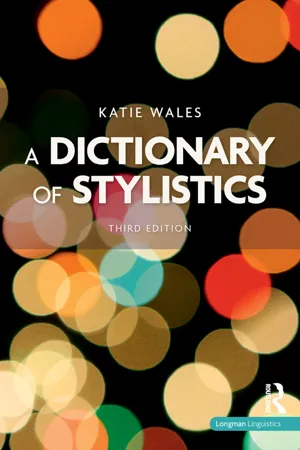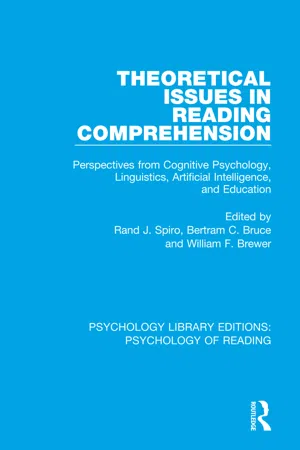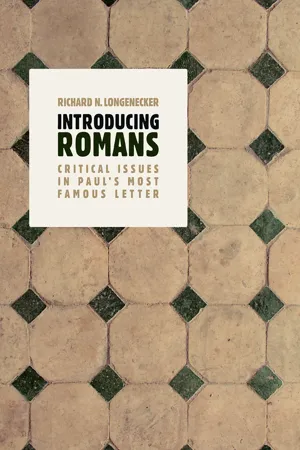Literature
Anaphora
Anaphora is a literary device where the same word or phrase is repeated at the beginning of successive clauses or sentences. It is used to create emphasis, rhythm, and emotional impact in writing. Anaphora is commonly employed in poetry, speeches, and other forms of literature to draw attention to key ideas and evoke a sense of unity and progression.
Written by Perlego with AI-assistance
Related key terms
1 of 5
3 Key excerpts on "Anaphora"
- eBook - ePub
- Katie Wales(Author)
- 2014(Publication Date)
- Routledge(Publisher)
DACTYL (/ x x). For example:(Lord Byron: The Destruction of Sennacherib)■ Anaphora; anaphoric reference(1) In RHETORIC Anaphora (Gk ‘carrying back’) is a popular FIGURE OF SPEECH involving REPETITION of the same word at the beginning of successive clauses, sentences or verses (also known as epAnaphora). It is found in verse and prose of all periods, and can be effectively deployed to underline descriptive and emotional effects, e.g.:The rain fell heavily on the roof, and pattered on the ground … The rain fell , heavily , drearily. It was a night of tears.(Charles Dickens: Little Dorrit, ch. 17 )It is common in public oratory, political or religious, to give structure to an argument, to ‘hammer home’ a point, or to arouse strong feelings, e.g.:‘… we shall fight on the beaches, we shall fight on the landing grounds, we shall fight in the fields and in the streets, we shall fight in the hills; we shall never surrender.’(Winston Churchill, June 1940)(2) In GRAMMAR and TEXT studies, Anaphora (adj. anaphoric) popularly denotes a kind of REFERENCE which is ‘backward-looking’ (as distinct from CATAPHORIC , ‘forward-looking’), both important aspects of the COHESION or connectedness of DISCOURSE (Michael Halliday & Ruqaiya Hasan 1976). So the third PERSON PRONOUNS (she, he, it, they) function typically with anaphoric reference, for NOMINALS as antecedents in the CO-TEXT :Little Bo-Peep has lost her sheep ,And doesn’t know where to find themThe DEFINITE ARTICLE (the) and DEMONSTRATIVES like that can also be anaphoric; as also in FORMAL or legal English, are explicit phrases like the aforesaid, the former, etc. SUBSTITUTE forms like do and one usefully avoid repetition, e.g. I thought you were changing your car. No, my flatmate did . She found a new one , actually.ELLIPSIS - eBook - ePub
Theoretical Issues in Reading Comprehension
Perspectives from Cognitive Psychology, Linguistics, Artificial Intelligence and Education
- Rand J. Spiro, Bertram C. Bruce, William F. Brewer, Rand J. Spiro, Bertram C. Bruce, William F. Brewer(Authors)
- 2017(Publication Date)
- Routledge(Publisher)
6 Syntax Beyond the Sentence: Anaphora Bonnie Lynn WebberCenter for the Study of Reading,Bolt Beranek and Newman Inc.INTRODUCTION
In understanding language understanding and, in particular, reading comprehension, it is almost a truism to say that one cannot stop at the analysis of single sentences. In comprehending text, the import of each successive sentence must be determined within, and integrated into, an incrementally growing model of the discourse. One can then ask: What devices in the text aid that integration, either by indicating connections or by lightening memory load? That is, what intersentential devices carry over to text that most important function of sentence-level syntax that Huggins (Chapter 4, this volume) describes as “a way of maximizing the rate of transfer of meaning from a language producer to a language receiver, taking into account the limitations of memory of the receiver?” What sorts of knowledge and processing heuristics must be possessed by the language receiver to handle such devices? What would result from their absence?One such intersentential device, Anaphora, is the subject of this survey. Anaphoric expressions comprise pronouns, pro-verbs, some definite noun phrases, and ellipses. They epitomize a device for “maximizing the rate of transfer of meaning”: for example, one short syllable, “it,” can evoke in the language receiver’s mind a complex theoretical construct or an entire chain of events leading to some conclusion.It was christened by Feynmann “the eight-fold way.”In the end, it drove Lear mad.There are certain fundamental assumptions about Anaphora in which this survey is grounded. First, it is assumed that there are differences in syntactic and semantic properties that divide Anaphora into two basic classes—deep and surface (Hankamer & Sag, 1976). Second, it is assumed that each discourse participant is incrementally synthesizing his or her own model of both the discourse and the external situation. In the case of definite pronouns—he, she, it, they, even s/he—the pronoun’s referent is an entity within the speaker’s current model. In using a definite pronoun, the speaker presumes that its referent corresponds to a similar - eBook - ePub
Introducing Romans
Critical Issues in Paul's Most Famous Letter
- Richard N. Longenecker(Author)
- 2011(Publication Date)
- Eerdmans(Publisher)
Chapter XI (“Structure and Argument”), attempting to show (1) how Paul made use of the rhetoric of Greco-Roman protreptic discourse—whether deliberatively (i.e., in order to make the greatest impact on his addressees) or somewhat unconsciously (i.e., simply because it was a type of rhetorical communication that was common to him and his addressees), and (2) how he accommodated it to his own purposes and filled it with his own Christian theology.Synchronic Rhetorical Analysis
Synchronic rhetorical analysis is a literary and compositional method that examines the argument of a speech or writing, identifies its modes of persuasion, and classifies its argumentative conventions. And Paul’s letter to the Christians at Rome, as do all of his extant letters, reflects a number of such synchronic rhetorical devices that seem to have been current in his day. Among the more obvious of these rhetorical techniques in Romans, the following may be mentioned—thereby fleshing out the list given earlier in the section “Rhetoric in the Ancient World” by focusing on the identification of such claimed occurrences in Paul’s letter:1. Anaphora (i.e., the repetition of a word or expression at the beginning of a series of successive phrases, clauses, sentences, or verses; or, as in an extended Anaphora, the repetition of a word or expression at the resumption of a discussion that has been interrupted by another section of material). The most obvious instance of Anaphora in the NT is in Heb 11:3-31, where πίστει (“by faith”) introduces eighteen examples of people who lived their lives trusting God. The nine occurrences of μακάριοι (“blessings”) in the “beatitudes” of Matt 5:3-12, as well as the four μακάριοι (“blessings”) and four οὐαί (“woes”) of Luke 6:20-26, are also instances of Anaphora. 103
Index pages curate the most relevant extracts from our library of academic textbooks. They’ve been created using an in-house natural language model (NLM), each adding context and meaning to key research topics.


